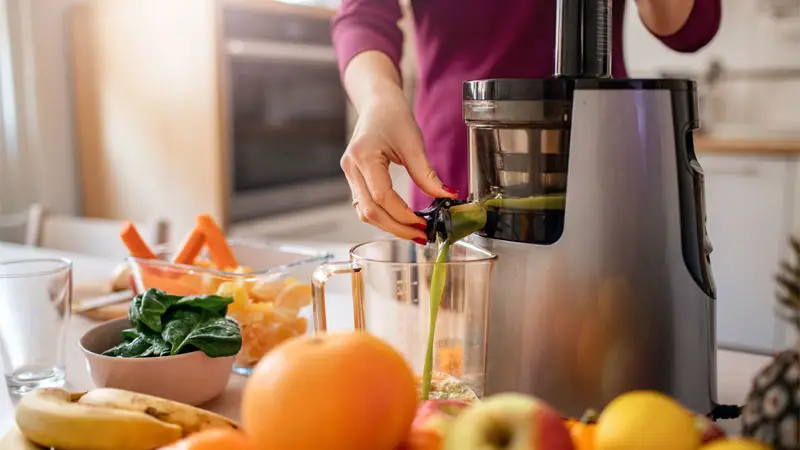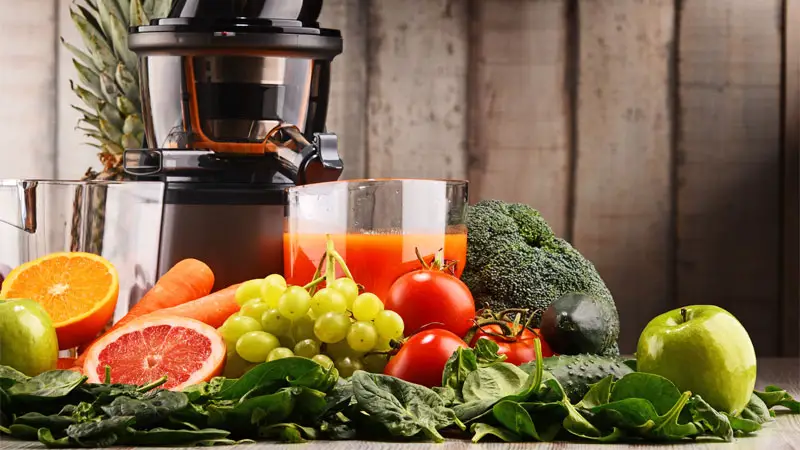Updated on August 12, 2022
Having cold-pressed juice at home is easy to do if you have a quality masticating juicer. But how does a masticating juicer work? Luckily, you’re in the right place to find out! If you’re new to juicing you’ve probably heard a few terms tossed around, and masticating is more than likely one of them.
A masticating juicer works by crushing the fruits and vegetables that you put into the juicer and squeezing all of the liquid out of the pulp. There are different types of masticating juicers so what the juicer does with the dry pulp can vary from appliance to appliance.
Masticating Juicer vs Centrifugal Juicer
If you don’t have much knowledge or experience when it comes to the juicers that are on the market, you’re probably wondering what the difference is between the various styles of juicers available. While they both offer the same basic function, the way they make the juice is different.
Masticating Juicer
A masticating juicer is designed to slowly crush and grind anything you put into it to force out the juice, causing no harm to any of the enzymes or vitamins in your fruits and vegetables. Because the juicing process doesn’t use any heat, you don’t lose any of the nutrients when you use a masticating juicer.
One of the biggest perks to using one of these great appliances is that the high yield of the machine makes this perfect for juicing leafy greens since it can extract all of the plant’s available liquid. A cold pressing juicer is a great choice for people that want the most nutrient-rich juice possible.
See Also – How to Make Cold Press Juice at Home
Centrifugal Juicer
If you are looking for a fast juicing time, centrifugal juicers would be a good choice for you. This type of juicer works best with more solid items such as carrots and apples. Many people prefer a centrifugal machine because the blades spin at high speeds, mashing the pulp against a mesh screen, extracting juice from the fruit quickly.
While they do make juice quickly, the speed of the blades heats the contents and can start the oxidation process. Oxidized juice isn’t bad, but it should be consumed right away for the best flavor.
Using a Masticating Juicer

Also known as a slow juicer, a cold-press juicer crushes fruits, vegetables, and leafy greens to release the juices. Aside from the health benefits, the biggest perk of using a slow juicer is that it has a much larger yield than a simple centrifugal machine.
Due to the slow crushing action, this style of juicer gets all of the juice out of the pulp.
How To Use a Masticating Juicer
- Choose your fruits and veggies. You can even pick leafy greens and softer produce. Be aware that some fruits and veggies (like tomatoes, apples, and leafy greens) produce more foam than others.
- Cut anything that may be too big for the chute into appropriately sized pieces.
- Feed your leafy greens, fruits, and veggies into the juicer and let it work. The slow juicer got its name from the fact that it takes longer to crush the items and squeeze the juice out of the pulp.
- Once no more juice is coming out of the machine, your juice is done.
Conclusion
I hope you are no longer wondering how a masticating juicer works. Just a quick recap, these slow cold-press juicers are a great choice because they grind and crush the fruits and vegetables, squeezing the pulp until you’re left with delicious juice and a cup of dry pulp.
While this is a slow process, the nutritious and vitamin-rich juice is worth the wait.

